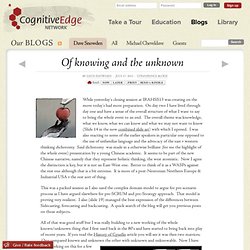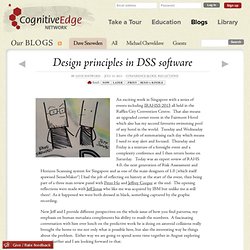

Enlivenment pdf - Andreas Weber. BlindSpot Think Tank – Blindspotting hard-to-solve problems. Human eyesight has a blindspot where the bundle of optic nerves and blood vessels enter our eyes.

A significant segment of our field of vision is missing though we don’t notice it’s missing because our brains hide these blindspots from perception. Image: My eye (colour edited). Like blindspots in problem-solving, the pale blindspot area has the most connections. Something similar happens when people try to solve problems caused collectively, such as armed conflict, financial instability, debt, inequality, resource depletion, ecological loss and climate change. Blindspots that we don’t notice stop us from attempting change at the scale and speed needed to seriously tackle these linterlinked problems. Blindspots persist in all change initiatives but some key examples include: Fortunately our problem-solving blindspots are not hardwired and unchangeable like the design of our eyeballs.
Past success came despite our blindspots. Of tittering, twittering & twitterpating - Cognitive Edge Network Blog. The collective noun for magpies is a tittering which is slightly less scary than their close relatives a murder of magpies.

It was one of the comments I made in my closing session at IRHASS13. Now I have been at all five IRHASS events and for the last three my role has been to provide an end point to each day. It's not so much a summary, its more the role of being a constructive irritant, a curmudgeonly but entertaining end to the day; a role that I enjoy. You can find the slides for both days here. I have developed a habit of using the first day to establish some contrary and challenging ideas and day two to provide some form of structure to understand what has gone before. Thereis a element of twitterpating about events of this kind, a falling in love in the springtime and my reference to magpies was a warning similar to that of Owl to Bambi. Aside from that I made a serious of points that apply more generally, as well as to the foresight community who were my primary targets.
Of knowing and the unknown - Cognitive Edge Network Blog. While yesterday's closing session at IRAHSS13 was creating on the move today's had more preparation.

On day two I have lived through day one and have a sense of the overall structure of what I want to say to bring the whole event to an end. The overall theme was knowledge, what we know, what we can know and what we may not want to know (Slide 14 in the now combined slide set) with which I opened. I was also reacting to some of the earlier speakers in particular one opposed to the use of unfamiliar language and the advocacy of the east v western thinking dichotomy. Said dichotomy was made in a otherwise brilliant (for me the highlight of the whole event) presentation by a young Chinese academic. It seems to be part of the new Chinese narrative, namely that they represent holistic thinking, the west atomistic. This was a packed session as I also used the complex domain model to argue for pre-scenario process as I have argued elsewhere for pre-SCRUM and pre-Strategy approach.
Design principles in DSS software. An exciting week in Singapore with a series of events including IRAHSS 2013 all held in the Raffles City Convention Centre.

That also means an upgraded corner room in the Fairmont Hotel which also has my second favourite swimming pool of any hotel in the world. Tuesday and Wednesday I have the job of summarising each day which means I need to stay alert and focused. Thursday and Friday is a mixture of a foresight event and a complexity conference and I then return home on Saturday. Today was an expert review of RAHS 4.0, the next generation of Risk Assessment and Horizon Scanning system for Singapore and as one of the main designers of 1.0 (which itself spawned SenseMaker®) I had the job of reflecting on history at the start of the event, then being part of a three man review panel with Peter Ho and Jeffrey Cooper at the end. The opening reflections were made with Jeff Jonas who like me was acquired by IBM but unlike me is still there!